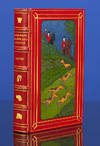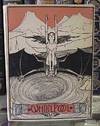![[TWO PRIMARY BUBBLE CHAMBER PAPERS] Bubble Chamber Tracks of Penetrating Cosmic-Ray Particles in Physical Review 91 No. 3, August 1, 1953, pp. 762-763 WITH Some Effects of Ionizing Radiation on the Formation of Bubbles in Liquids in Physical Review 87 No. 4, p. 665, August 15, 1952](https://d3525k1ryd2155.cloudfront.net/h/717/832/1109832717.0.m.jpg)
[TWO PRIMARY BUBBLE CHAMBER PAPERS] Bubble Chamber Tracks of Penetrating Cosmic-Ray Particles in Physical Review 91 No. 3, August 1, 1953, pp. 762-763 WITH Some Effects of Ionizing Radiation on the Formation of Bubbles in Liquids in Physical Review 87 No. 4, p. 665, August 15, 1952
by Glaser, Donald Arthur
- Used
- Paperback
- first
- Condition
- See description
- Seller
-
West Branch, Iowa, United States
Payment Methods Accepted
About This Item
Lancaster: American Physical Society. 1st Edition. FIRST EDITION IN ORIGINAL PRINTED WRAPS OF TWO PAPERS: DONALD GLASER'S BRIEF 1952 ANNOUNCEMENT OF HIS FIRST EXPERIMENT WITH HIS BUBBLE CHAMBER & HIS 1953 PAPER FULLY DESCRIBING HIS INVENTION AND SUMMARIZING ITS USE IN OBSERVING AND PHOTOGRAPHING THE TRACKS AND LIFETIMES OF PARTICLES. Glaser's invention was a major breakthrough in sub-atomic particle physics. His "investigation of interactions involving short-lived particles, [facilitated] the discoveries by Luis Alvarez and others at Lawrence- Berkeley National Laboratories, among others" (History of Physics: The Wenner Collection). He was awarded the 1960 Nobel Prize in Physics for this invention. "American physicist and neurobiologist Donald Arthur Glaser undertook a search for a better mechanism for tracking small charged particles, and settled on the idea of a superheated liquid. He found the published version of a 1924 study of superheated liquids and realized that the random beginning of boiling in the superheated ether described in the study was probably initiated by cosmic rays. Any disturbance in a superheated liquid causes local vaporization to occur, causing a bubble to form. As the particle moves through the liquid, it leaves a track of bubbles" (ibid). As stated in the Nobel Prize presentation speech, "Glaser's idea was that an atomic particle passing through the liquid would be able to provoke boiling by means of the ions which the atomic particle produces along its path and which act as bubble-development centers. If a flash picture were subsequently taken of the superheated liquid immediately after an atomic particle passes through, one ought to be able to observe the particle's path which is followed by the small bubbles which would have been produced" (Nobel Prize Presentation). This was the basis of Glaser's idea and, working according to very systematic plans and experiments, he built a device - first one as small as his thumb and then a full—sized one -- consisting of a tank of pressurized liquid which, when superheated by reducing its pressure, caused charged particles to pass through the tank, stripping electrons from atoms in the liquid and causing the liquid to boil. While initially microscopic, as the chamber expanded the bubbles grew in size, and as Glaser has hoped, grew large enough to become a very effective way to detect, visualize, and photograph the paths and lifetimes of particles. CONDITION & DETAILS: Lancaster: American Physical Society. Two issues in original wraps. Complete. 4to (10.5 x 8 inches; 263 x 200mm). The 1952 issue is in near fine condition inside and out. The 1952 issue has been professionally rebacked at the spine and has slight toning at the edges of the wrap (very good +); the interior is near fine.
Details
- Bookseller
- Atticus Rare Books
(US)
- Bookseller's Inventory #
- 1063
- Title
- [TWO PRIMARY BUBBLE CHAMBER PAPERS] Bubble Chamber Tracks of Penetrating Cosmic-Ray Particles in Physical Review 91 No. 3, August 1, 1953, pp. 762-763 WITH Some Effects of Ionizing Radiation on the Formation of Bubbles in Liquids in Physical Review 87 No. 4, p. 665, August 15, 1952
- Author
- Glaser, Donald Arthur
- Book Condition
- Used
- Quantity Available
- 1
- Edition
- 1st Edition
- Binding
- Paperback
- Publisher
- American Physical Society
- Place of Publication
- Lancaster
Terms of Sale
Atticus Rare Books
30 day return guarantee, with full refund including shipping costs for up to 30 days after delivery if an item arrives misdescribed or damaged.
About the Seller
Atticus Rare Books
Biblio member since 2010
West Branch, Iowa
About Atticus Rare Books
We specialize in rare and unusual antiquarian books in the sciences and the history of science. Additionally, we specialize in 20th century physics, mathematics, and astronomy.
Glossary
Some terminology that may be used in this description includes:
- Edges
- The collective of the top, fore and bottom edges of the text block of the book, being that part of the edges of the pages of a...
- Device
- Especially for older books, a printer's device refers to an identifying mark, also sometimes called a printer's mark, on the...
- First Edition
- In book collecting, the first edition is the earliest published form of a book. A book may have more than one first edition in...
- Rebacked
- having had the material covering the spine replaced. ...
- Fine
- A book in fine condition exhibits no flaws. A fine condition book closely approaches As New condition, but may lack the...
- Leaves
- Very generally, "leaves" refers to the pages of a book, as in the common phrase, "loose-leaf pages." A leaf is a single sheet...
- Spine
- The outer portion of a book which covers the actual binding. The spine usually faces outward when a book is placed on a shelf....

